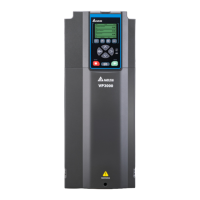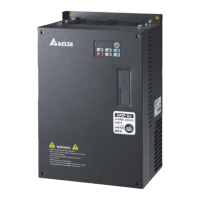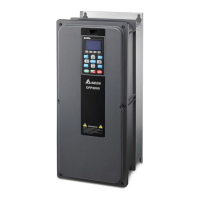Chapter 8 Troubleshooting|VP3000
498
Over-voltage during
acceleration
(ovA)
DC bus over-voltage during acceleration.
When ovA occurs, the drive closes the gate of the output, the motor runs freely,
and the display shows an ovA error.
Immediately acts when DC bus voltage is higher than the condition
Fault Treatment Parameter
Reset only when DC bus voltage is lower than 90% of the over-voltage condition
Acceleration is too slow (e.g.,
lifting load decreases acceleration
time)
Decrease the acceleration time.
Replace the drive with a larger capacity model.
The setting for stall prevention
condition is smaller than no-load
current
The setting for stall prevention condition should be larger than no-load current
Power voltage is too high
Check if the input voltage is within the rated AC motor drive input voltage range,
and check for possible voltage spikes.
ON/OFF switch action of phase-in
capacitor in the same power
system
If the phase-in capacitor or active power supply unit acts in the same power
system, the input voltage may surge abnormally in a brief time. In this case, install
an AC reactor.
Regenerative voltage of motor
inertia
Use over-voltage stall prevention (Pr. H1-08).
Use a brake unit or DC bus.
Acceleration time is too short
Check if the over-voltage warning occurs after acceleration stops. When the
warning occurs, do the following:
1. Increase the acceleration time.
2. Set Pr. H1-08 over-voltage stall prevention.
3. Increase setting value for Pr. C2-09 S-curve acceleration arrival time 2
The ground short circuit current charges the capacitor in the main circuit through
the power. Check if there is ground fault on the motor cable, wiring box and its
internal terminals.
Troubleshoot the ground fault.
Malfunction caused by
interference
Verify the wiring of the control circuit and wiring/grounding of the main circuit to
prevent interference.

